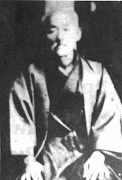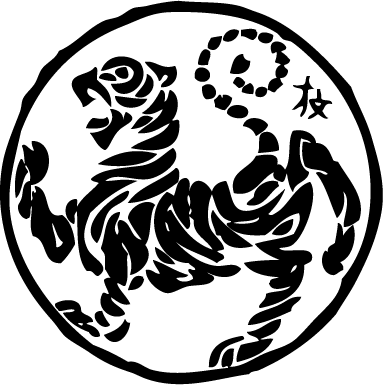A Brief History of Karate
松濤館 Shotokan
Shotokan-style Karate was developed by Master Gichin Funakoshi.
The Martial Art School known as Shotokan has a long and rich history dating back 18th century. Formalized as a school in 1939 by Gichin Funakoshi based on Okinawan Karate, its Shotokai and Shotokan Masters have shared this magnificent art throughout the world.
Today there are many schools = kan and variations of Master Funakoshi's Karate.
OKINAWAN KARATE
Two kinds of styles found their way to Okinawa, and had their influence on Okinawa’s own original fighting method, called Okinawa-te (Okinawan hand) or simply te. A ban on weapons in Okinawa for two long periods in its history is also partly responsible for the high degree of development of unarmed fighting techniques on the island.
Karate in Okinawa developed from the synthesis of two fighting techniques. The first one, used by the inhabitants of Okinawa, was very simple but terribly effective and, above all, very close to reality since it was used throughout many centuries in real combat. The second one, much more elaborate and impregnated with philosophical teachings, was a product of the ancient culture of China. These two origins explain the double character of Karate–extremely violent and efficient but at the same time a strict and austere discipline and philosophy with a non-violent emphasis.
The Okinawans combined Chinese martial arts with the existing local variants to form Tōde (唐手). The Okinawan characters for Tōde where translated in Japanese as Kara Te. The style of Karate based on Gichin Funakoshi's teachings was simply called Karate.
SHOTOKAN KARATE
Karate in Okinawa continued to grow and garner interest, but was solely Okinawan. In an effort to expand the reach of Karate, Master Funakoshi ventured to mainland Japan in 1922 to promote its practice.
Master Funakoshi, Yoshitaka Funakoshi, Shigeru Egami, and Takeshi Shimoda traveled throughout mainland Japan staging exhibitions, trying to expand the knowledge of Karate-do as a Japanese martial art.
They organized and established a school or Dojo that his senior students later associated with teachings under his pen name Shoto (松濤). Shoto meaning "pine-waves" or the movement of pine needles when the wind blows through them. Shoto was then combined with Kan (館) meaning "house" of training and became know as Master Funakoshi's style Shotokan (松濤館). In some instances, you will see ryu (流) attached to the end of Shotokan denoting "school".
JAPANESE SHOTOKAN KARATE
Master Funakoshi, Yoshitaka Funakoshi (Master's son aka Gigo), Shigeru Egami, and Takeshi Shimoda, and other seniors students continued to adapt and meld Shotokan Karate with Japanese Martial Arts and Philosophy brought about the evolution to Japanese Shotokan Karate. Their efforts found purchase in many of Japan's higher education academic institutions including Waseda University, Keio University, and others.
Hoan Kosugi, friend and student of Master Funakoshi [Keio University] created the Shotokan Tiger or “Tora no Maki,” or the Tiger Scroll. He also encouraged Master Funakoshi to document his techniques in a book, which became Kyohan.
Master Funakoshi became increasingly busy Shotokan dojo and writing Kyohan. He began handing over his teaching assignments at the various universities to his students. He still conducted demonstrations, including regular performances before Emperor Hirohito, who invited him to the Imperial Palace on an annual basis.
The Pacific War started in 1941, and times grew hard in Japan. Master Funakoshi's third son, Gigo, who was supposed to inherit his father's school, died of tuberculosis in 1945. A few months later, Master Funakoshi's dojo was destroyed by Allied bombers. In that same year, the battle for Okinawa began and many people fled to the island of Kyushu, including Funakoshi's wife, who had remained in Shuri during his residence in Tokyo. The couple were reunited at a refugee camp on Kyushu, and he stayed with his wife until her death in 1947. He then boarded a train for Tokyo to start all over again.
In 1945, the Empire of Japan surrendered to the Allies.
The occupying forces disallowed martial arts instruction.
Because of Master Funakoshi's association with the Universities and with the Ministry of Education, karate was classified as physical education, not a martial art. He therefore began teaching again, and within a few years was drawing martial artists from other disciplines, all of whom were longing for a place to practice. Included among these new recruits were American servicemen, who were amazed at this form of exercise. For every GI who returned to the United States with a karate tale, Funakoshi received two more letters from Americans, who wished to become students.
He had spread karate throughout Japan, now it was time to spread it throughout the world. In 1953, after several requests from Americans for qualified karate instructors, he began sending some of his finest students around the world to begin teaching Karate. Through their efforts Shotokan-ryu became one of the first and most widely practiced styles in Japan post World War II. In 1957, at age 89, Master Funakoshi died in his sleep, leaving behind a legacy that of which he took little credit for karate's immense popularity, but few denied that he had almost single-handedly brought the art to Japan and subsequently sent it overseas.
MODERN SHOTOKAN KARATE
Upon bringing karate to Japan and seeing it's traditional martial arts, such as judo and kendo, Master Funakoshi patterned karate after these arts to a large degree and made karate popular. He held many conversations with fellow Masters incluiding Jigoro Kano the founder of Judo and Morihei Ueshiba founder of Aikido. Once again he evolved and combined his karate techniques by applying his philosophy. He continuted to develop Karate and capture the essence of traditional budo (the martial way) in his Te.
As with so many things in life, adaptation and evolution are natural. Shotokan-ryu Karate is no exception. The influence of people, environment, technology, and other social aspects of life affect its propagation. The principles and basics of Master Funakoshi's Karate are not identical the "te" he learned from his teachers Yasutsune Azato and Anko Itosu. So it is for Master Funakoshi's son Yoshitaka, and the many great Karate-ka who learned directly from O-sensei. Today, their students continue to explore and evolve Karate. Each can explore the depth of martials way in pursuit of budo and find steadfast truths based on Master Funakoshi's key prinicples, and areas of improvement where O-sensei himself admitted was necessary.
Modern Karate is often defined by the written text such as Kyohan, however as insightful as Master Funakoshi was, he knew that the text would only be a guide, and the true karate would explore beyond the text.
Budo Karate emerged after World War II as a movement away from the anachronistic ways of the Samurai and Bushido. Martial artists sought a higher level of sophistication and attainment losing some of the rigidity that was introduced by training for warfare to karate for a deeper understanding of the art. Sometimes finding the depth that came from years prior to the war, and often in combination with the current knowledge of the body and mind. The budo way is life long pursuit of self perfection as a fusion of body, mind, and spirit.









